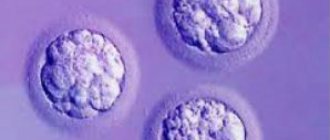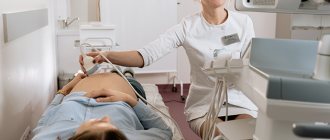On what day do the first signs appear?
For conception to occur, a combination of certain factors is necessary:
- ovulation must occur;
- the presence of viable sperm in the fallopian tubes;
- absence of gynecological pathologies and hormonal abnormalities in women.
When does ovulation occur? In women with an average menstrual cycle of 28–30 days, the egg is released and the follicle is released in the middle of the cycle – 12–16 days after the start of menstruation. If at this moment she meets a sperm, then the probability of conception is approximately 35–40%.
The main ghost of ovulation is copious white discharge that stretches well and looks like a raw egg block. Other symptoms - soreness and sensitivity of the mammary glands, nipples, pulling sensations in the lower abdomen, headache, increased libido - appear in women with varying degrees of intensity, or may be completely absent.
If the intervals between critical days differ from the statistical average, then to find out the day of ovulation, you need to subtract 14 from the number of days in the cycle. With irregular periods, it is difficult to calculate the date of release of the egg; you need to use special tests.
But pregnancy after fertilization does not occur immediately; after the fusion of the female and male cells, the division of the egg begins, while it actively moves through the tubes into the uterine cavity. This process takes on average 10–12 days, during which time the endometrium becomes loose and progesterone begins to be actively produced - these conditions are necessary for normal childbearing.
Table “On what day of the cycle may signs of pregnancy appear”
| Cycle length (days) | Approximate date of ovulation (cycle day) | When signs of pregnancy may appear (day of cycle) |
| 21 | 5–9 | 15–19 |
| 24–25 | 10–11 | 20–22 |
| 26–30 | 12–16 | 22–27 |
| 31–32 | 14–18 | 24–29 |
| 33–35 | 19–21 | 29–32 |
| 36–38 | 22–24 | 32–35 |
| 38–40 | 24–26 | 34–36 |
Important! After leaving the follicle, the egg lives no more than 48 hours, but sperm under favorable conditions can remain active in the fallopian tubes for 3–7 days. Therefore, not only the day of ovulation, but also the 5 days before and after are considered favorable for conception.
How does it hurt during menstruation?
Symptoms of menstrual pain and cramps can vary depending on the individual.
Some women experience a dull, throbbing pain, while others experience severe and often debilitating pain in the lower abdomen, ovarian area, radiating to the lower back, thighs, and rectum. Pain usually begins one to three days before menstruation, peaks 24 hours after bleeding begins, and subsides after two to three days. Some girls before menstruation, in addition to pain, also experience nausea, headache, dizziness and loose stools.
Causes of painful periods
Our uterus consists of two main layers. The outer muscle layer, the myometrium, is composed of smooth muscle cells. The inner layer, the endometrium, responds to changes in hormone levels. The endometrium accumulates during the first half of the menstrual cycle in preparation for pregnancy. If conception does not occur, hormonal changes cause the endometrium to release substances known as prostaglandins. They cause the muscles of the uterus, the myometrium, to contract, which causes the endometrial lining to come out through the vagina - this is your monthly menstruation.
A healthy female body naturally produces prostaglandins, which have hormone-like effects. They are involved in various body functions, including contraction of the uterine muscles, which causes pain and causes primary algomenorrhea or menstrual cramps.
At the beginning of your period, the levels of prostaglandins in your body are higher than normal. As a rule, the higher their level, the stronger the pain during menstruation. In contrast, if you are not menstruating due to hormonal contraception, postpartum lactation, or approaching menopause, there is little or no risk of cramping.
The risk of severe menstrual cramps is higher if you smoke, are under 30 years of age, have heavy or irregular bleeding, started puberty before age 12, or have a family history of close female relatives (mother, aunt, grandmother) having very painful periods .
What to do if periods are painful?
If, due to pain before and during menstruation, you miss school, days at work, sports or other activities at least one day a month, contact our gynecology doctor in Moscow. Although menstruation is a normal part of your body's functioning, it is not normal if it is severe enough to disrupt your normal, daily activities.
No matter what, don’t suffer in silence: painful periods are not something you are doomed to live with. The pain can often be successfully treated. Our clinic’s specialists have many safe and effective methods for treating algodismenorrhea, allowing you to effectively and almost 100% get rid of painful periods!
Early signs of pregnancy
After the egg is fixed in the uterus, radical changes begin to occur in the body, albeit still imperceptible, outwardly imperceptible. But in some women, symptoms of pregnancy appear already in the first days after conception, but often these signs are in many ways similar to the manifestation of PMS. Against the background of changes in the hormonal background, the emotional background changes - irritability, tearfulness, and sudden mood swings appear.
What sensations are observed at the beginning of pregnancy:
- Yellow or bloody discharge, pulling in the lower abdomen
- occurs 10-12 days after ovulation, when the egg is fixed in the uterus. Normally, after a maximum of 2 days, this symptom should disappear. - Cramps at night
- during pregnancy, most of the calcium is spent on building the child’s bone tissue; the lack of this element causes discomfort in the limbs. - Decreased blood pressure
- after conception, radical changes occur in a woman’s circulatory system, an additional circle is formed to nourish the placenta, all this provokes the development of hypotension. Pathology can appear already in the first week, manifesting itself in the form of dizziness, weakness, nausea, swelling of the face; high levels of progesterone can also provoke the development of hypotension. - Drowsiness, increased fatigue
- the body spends a lot of energy maintaining the life and development of the fetus, so the woman constantly feels tired. - Swelling of the mammary glands
- this is how the body prepares for breastfeeding; the breasts hurt during almost the entire pregnancy. - Tingling in the uterus, frequent urination, discomfort in a sitting position, nagging pain in the lower back
- occurs against the background of increased blood circulation in the pelvic organs, changes in kidney function. - Toxicosis
- the body perceives the fetus as a foreign body, nausea and vomiting appear, and sometimes there is an increase in body temperature to subfebrile levels.
Some disorders of the digestive system - constipation, bloating, lack of appetite, or an increase in appetite - may also indicate pregnancy. This is due to the fact that from the first days after conception the intestines begin to work more slowly. Diarrhea may also occur as the body's reaction to stress.
Often pregnant women complain of severe itching - the skin itches due to high estrogen content and increased load on the liver. But such a sign may indicate the presence of serious illnesses; it is necessary to consult a doctor.
One of the most reliable first signs of pregnancy is basal temperature. If a woman regularly plots a graph, then upon conception, you will notice that after ovulation the values do not decrease, but remain at a level of 37.1 degrees or more. You can see what the basal values curve looks like in the photo.
What is algodismenorrhea
Any woman who has experienced childbirth can say that the uterus is a strong muscle, capable of very intense contractions. What you may not know is that the normal changes that cause you to bleed every month also cause your uterus to contract. These contractions—menstrual cramps—are not as severe as during labor and can be quite mild. But for many women, the discomfort can be serious and then we are talking about such a diagnosis as algodismenorrhea.
Algodismenorrhea in women is a monthly pathological condition that refers to pain during menstruation that occurs as a result of gynecological diseases, abnormal position of the uterus, as well as increased excitability of the central nervous system. Painful periods are very often accompanied by a complex of vegetative symptoms such as weakness, dizziness, cramping, “hellish” pain in the lower abdomen, nausea, vomiting, diarrhea, bouts of fever and sweating.
Primary algodismenorrhea
Most often it occurs in young women, teenage girls 14-15-16 years old, who have only recently begun their menstrual cycle. These cramps are strong contractions of the uterus caused by substances in the body called prostaglandins. Because their levels in the uterus rise immediately before the onset of menstruation, women usually experience pain on the first day or two or three of its onset. As the lining of the uterus sheds through menstrual bleeding, the level of prostaglandins decreases, and with this, cramping decreases or disappears completely.
Symptoms of primary algodysmenorrhea, associated with gynecological pathology, often become less pronounced when a woman reaches her mid-20s or after the birth of a child.
Secondary algomenorrhea
The gynecologist makes this diagnosis when pain during menstruation and abdominal cramps are the result of existing, previous gynecological diseases (endometriosis, adenomyosis, inflammation of the uterus and appendages, fibrous tumors and ovarian cysts, infections, adhesions in the pelvis, etc.), surgical abortions and surgeries on the genitals, use of an intrauterine device.
Unlike primary dysmenorrhea, secondary dysmenorrhea may begin later in life, and menstrual pain may get worse rather than better as a woman gets older. Moreover, while the pain of primary dysmenorrhea lasts only a day or two, the pain of secondary dysmenorrhea can become more severe as the period progresses and even persist after the bleeding has stopped.
How to determine pregnancy before missed period?
In addition to sensations and external changes, you can find out about pregnancy before a missed period using special tests or traditional methods.
How can you determine pregnancy:
- HCG analysis
- after conception, the placenta begins to secrete a specific hormone, the levels of which increase throughout pregnancy. The test can be done 10 days after ovulation; it must be taken in the morning on an empty stomach. - Ultrasound
is one of the most accurate methods for determining pregnancy, but a good specialist will be able to see the presence of an egg only 5-7 days after the delay. - Pregnancy test
- a small amount of hCG is also present in the urine, which allows you to determine conception using simple tests yourself. For analysis, it is better to use a morning urine sample, choose tests with a sensitivity of 10 mIU/ml; a weak second line may appear 7–9 days after ovulation. - Iodine
- wet a napkin in a portion of morning urine, drop some silent iodine, during pregnancy the spot will acquire a rich purple color. You can drop iodine directly into a container with urine; if the drop does not sink, the test can be considered positive. - Soda
- add 3-5 g of soda to a bowl with morning urine; during pregnancy, the powder settles to the bottom; if conception does not occur, the urine begins to foam.
→ Review of the 5 best pregnancy tests
Why is it important to know about early pregnancy?
During pregnancy, every week matters, but it is in the first trimester that the main internal organs of the child are formed. If you learn to correctly identify the first signs of conception, you can promptly adjust your lifestyle and diet to avoid miscarriage, and conduct early diagnosis to identify genetic diseases.
Often at the initial stage of pregnancy, symptoms similar to colds appear. If a woman suspects conception, medications that are safe to take in the first trimester should be selected.
Signs of abnormalities
Pregnancy does not always develop normally after fertilization; various pathological processes occur in the early stages of pregnancy in 5–10% of women.
The main deviation that occurs in the early stages is an ectopic pregnancy, a fertilized egg is fixed in the fallopian tube, the abdominal cavity.
How to recognize an ectopic pregnancy:
- profuse bleeding of brown or brown color;
- acute or constant nagging pain in the lower abdomen, discomfort intensifies when changing body position;
- weakness, fever, chills are signs of an inflammatory process;
- severe decrease in blood counts, fainting.
If such symptoms appear, you must immediately consult a doctor; emergency surgery is required.
After conception, various changes begin to occur in a woman’s body, which are manifested by a number of characteristic signs. But often the symptoms are controversial; they may indicate PMS or illness. If you suspect pregnancy, do several tests at home, and after your period is missed by 2-3 days, visit a gynecologist.
Causes of lower abdominal pain in women
Physiological changes during pregnancy
During normal gestation, women experience short-term, mild pain in the lower abdomen. They are caused by an increase in the size of the uterus and overstretching of the ligaments that support it. In the second and third trimesters, the enlarged uterus puts pressure on neighboring organs, which also causes discomfort in the expectant mother. Pain can occur with bloating, which is often observed in pregnant women.
Pathologies of pregnancy
During gestation, acute pain in the lower abdomen indicates the development of complications. When spontaneous abortion occurs, women experience sharp, paroxysmal pain in the suprapubic and sacral area. It appears suddenly and can be triggered by a blow to the stomach, heavy lifting, or a stressful situation. The pain syndrome is accompanied by bloody discharge from the genital tract, which indicates an abortion in progress.
Severe paroxysmal or aching dull pain in the lower abdomen, combined with bleeding, may indicate premature placental abruption. The lower abdomen becomes hard and tense, and when palpating this area, the pain increases. Sometimes the pain syndrome is so intense that some women lose consciousness. The condition mainly develops after the 20th week of pregnancy.
Aching pain in the lower abdomen on the right or left occurs in women with an ectopic pregnancy. They may be accompanied by engorgement of the mammary glands, changes in appetite, and delayed menstruation. An interrupted tubal pregnancy is characterized by sharp pain in the lower abdominal cavity, which radiates to the perineum, lower back, and thigh. Bloody or brown spotting from the vagina is common.
Algomenorrhea
It is the most common cause of lower abdominal pain in women of reproductive age. Soreness appears 12-24 hours before the start of menstruation. For most women, the pain is nagging or aching in nature, of moderate intensity, and is eliminated with the help of conventional analgesics or antispasmodics. The most intense cramps are observed on the first day of menstruation, then they decrease. For 3-4 days you may feel slight discomfort in the lower abdomen.
With moderate and severe algomenorrhea, women experience severe cramps in the lower abdomen with irradiation to the lumbar region. The pain becomes more severe when turning and bending the body, coughing and sneezing, and straining. Severe pain affects the ability to work and activity of women. In addition to pain, psycho-emotional instability, weakness and dizziness, nausea and stool disorder are noted.
Pain in the lower abdomen in women
Inflammatory diseases of the reproductive system
Pain above the pubis and in the lateral abdomen is characteristic of endometritis and adnexitis. In acute inflammation, women are bothered by intense constant or paroxysmal pain, which is more pronounced on the side of inflammation. Acute endometritis is characterized by pain in the lower abdomen without clear localization. Against the background of pain, body temperature rises, general weakness increases, and various vaginal discharges are possible.
In the chronic form of adnexitis, moderate aching pain in the lower abdomen is observed, and short-term cramps occasionally occur. The pain intensifies after hypothermia, under stress, and with concomitant viral or bacterial processes. With chronic endometritis, nagging pain is felt, accompanied by menstrual irregularities. A pathognomonic sign is a sharp increase in pain during sexual intercourse.
Endometriosis
Depending on the location of endometriosis, pain in the lower abdomen has different characteristics. Most women complain of vague pulling or aching sensations in the pelvis, which intensify before menstruation. The pain syndrome reaches its maximum intensity in the first 2-3 days of menstruation. Often, pain in the pubic area intensifies during intimate relationships.
Neoplasms
The most common tumor formation of the genitals in women is uterine fibroids. Interstitial and subserous fibroids are characterized by constant dull pain in the pelvic cavity. With submucous fibroids, women suddenly feel severe cramps. It is typical to change the intensity of the pain syndrome in different phases of the monthly cycle. The pain is accompanied by menorrhagia and acyclic uterine bleeding.
Malignant tumors of the uterus are characterized by constant pain in the lower abdomen, which worsens as the tumor grows. Sometimes the pain radiates to the lower back, sacrum, and rectum. With cancer of the uterus, cramping painful sensations occur for no apparent reason. After a painful attack, as a rule, bloody or bloody vaginal discharge appears.
Chronic pelvic pain syndrome
With CPPS, women complain of painful sensations of varying strength and nature that bother the patient for at least 6 months. The pain is localized in the lower abdomen, perineal and pubic area. They may irradiate to the hip joints and buttocks. The pain syndrome intensifies with physical exertion and hypothermia. Pain in the lower abdomen also appears during sexual intercourse and vaginal examination.
Diseases of the urinary system
A common cause of lower abdominal pain in women is cystitis. In acute inflammation, patients constantly experience pain in the suprapubic region, which varies in intensity - from slight discomfort to unbearable pain. There is a frequent imperative urge to urinate, urine leakage is accompanied by increased pain in the lower abdomen. Sometimes women notice a strong unpleasant odor and cloudy urine.
Dull pain above the pubis, intensifying at the end of urination, is typical for bladder polyps. With a malignant process in the bladder, there is constant severe pain above the pubis. Sometimes pain in the lower abdomen occurs with pyelonephritis or ureteritis. For these diseases, pain in the lower back is more typical, however, when urinating, a woman may feel discomfort in the suprapubic area.
Intestinal infections
Paroxysmal pain in the lower abdomen is typical for infections that occur with colitis syndrome. These include escherichiosis, shigellosis, yersiniosis and campylobacteriosis. Women are bothered by severe cutting pains, accompanied by a painful urge to defecate. After bowel movement, the pain subsides for a short time. Diarrhea develops 10 or more times a day, stool contains a large amount of mucus, and sometimes streaks of blood.
Hernias
Pain in the lower abdomen is observed in women with inguinal hernias, hernias of the white or Spigelian lines. Pain occurs when straining or squeezing the abdominal organs with tight clothing or a belt. Over time, due to the increase in hernial protrusion, the pain becomes permanent. Acute pain in the area of the hernial sac and the inability to reduce it into the abdominal cavity indicate a strangulated hernia.
Appendicitis
Inflammation of the appendix is characterized by pain on the right in the iliac region, but sometimes pain is felt above the pubis. The localization of pain depends on the location of the appendix in the abdominal cavity. With appendicitis, you experience severe constant pain, accompanied by muscle tension in the right iliac region. After the onset of pain, there may be one or two episodes of vomiting, diarrhea, or stool retention.
Rare causes
- Limited purulent inflammation
: pouch of Douglas abscess, tubo-ovarian abscess. - Inflammatory bowel disease
: nonspecific ulcerative colitis (UC), Crohn's disease. - Blunt abdominal trauma.
- Prolapse of the uterus and vagina.
- Emergency conditions in gynecology
: ovarian apoplexy, torsion of the pedicle of an ovarian tumor. - Vascular pathologies
: varicose veins of the small pelvis, inferior vena cava syndrome.









